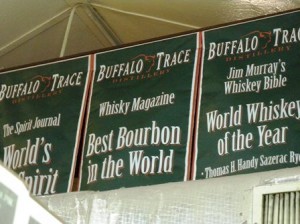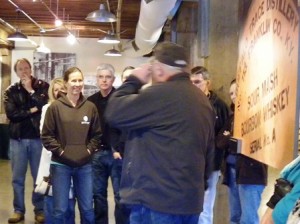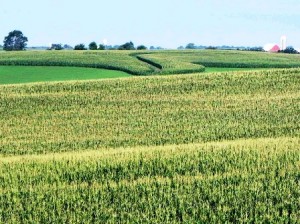Archive for April 5th, 2013
» posted on Friday, April 5th, 2013 by Linda Lou Burton
Liquid Corn
 Linda Burton posting from Frankfort, Kentucky – “It was used for medicinal purposes,” Fred answered. “It’s been said there were more sick people in Kentucky during prohibition years than at any other period of time.” This brought a laugh from the group; twenty people gathered for the beginning of a tour of Buffalo Trace, a Frankfort bourbon distillery that’s been in business over 200 years. Fred had told us it was a continuous operation “even during Prohibition,” so of course I asked how they got permission from the federal government to stay open. “The doctor wrote out a prescription and you dropped by to pick up your pint,” he continued. Ah, so people were after its “curative” properties! Bourbon whiskey is, by definition, mostly corn, Fred
Linda Burton posting from Frankfort, Kentucky – “It was used for medicinal purposes,” Fred answered. “It’s been said there were more sick people in Kentucky during prohibition years than at any other period of time.” This brought a laugh from the group; twenty people gathered for the beginning of a tour of Buffalo Trace, a Frankfort bourbon distillery that’s been in business over 200 years. Fred had told us it was a continuous operation “even during Prohibition,” so of course I asked how they got permission from the federal government to stay open. “The doctor wrote out a prescription and you dropped by to pick up your pint,” he continued. Ah, so people were after its “curative” properties! Bourbon whiskey is, by definition, mostly corn, Fred  continued, and I visualized the rows of corn my Granddad planted; his cornfield stretched all the way from the house to the railroad track. “Don’t put the water on to boil till you head out the door to pick the corn,” Granddad would say, when corn-on-the-cob season finally arrived; he believed it had to be that fresh to be good. So I grew up with corn, the juiciest, sweetest, most delicious vegetable God ever created. And easy to grow. That’s why American pioneers (British-French-German-Irish-Scottish-Welch) planted it as they moved westward across the Alleghenies after the Revolutionary War, into
continued, and I visualized the rows of corn my Granddad planted; his cornfield stretched all the way from the house to the railroad track. “Don’t put the water on to boil till you head out the door to pick the corn,” Granddad would say, when corn-on-the-cob season finally arrived; he believed it had to be that fresh to be good. So I grew up with corn, the juiciest, sweetest, most delicious vegetable God ever created. And easy to grow. That’s why American pioneers (British-French-German-Irish-Scottish-Welch) planted it as they moved westward across the Alleghenies after the Revolutionary War, into  the vast open farmlands that eventually became Kentucky. The soil was rich, the sun was warm, and the corn grew. Now think about it – how much corn can you eat, or feed to your animals, and then, how much corn can you sell? Roads were bad back then; shipping was costly, and timing was a factor. Turn it into a liquid; that was the profitable answer. And so bourbon whiskey was born. » read more
the vast open farmlands that eventually became Kentucky. The soil was rich, the sun was warm, and the corn grew. Now think about it – how much corn can you eat, or feed to your animals, and then, how much corn can you sell? Roads were bad back then; shipping was costly, and timing was a factor. Turn it into a liquid; that was the profitable answer. And so bourbon whiskey was born. » read more
